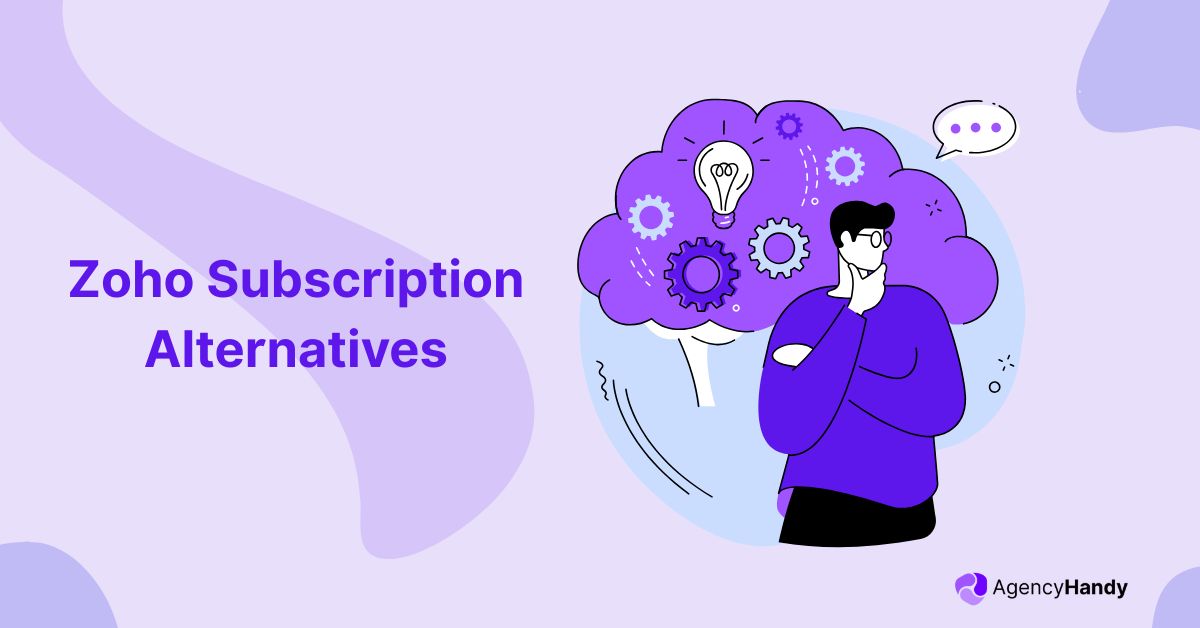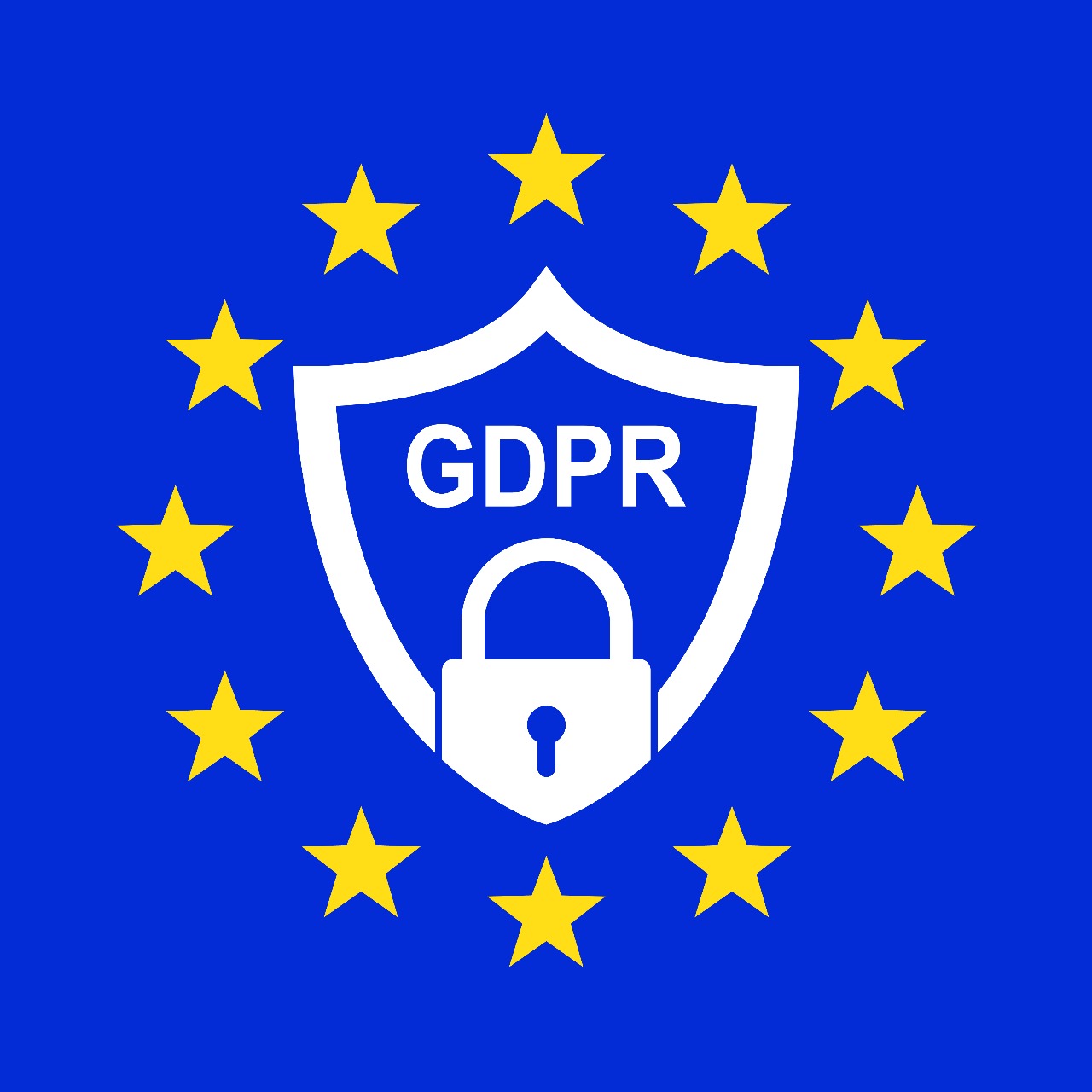Running an agency sounds good and cool.
Until you’re knee-deep in half-finished projects, messy feedback, and a team that’s constantly asking, “Where’s that thing again?”
Task boards here. Spreadsheets there. Slack blowing up.
You try a few tools. They help… until they don’t.
One doesn’t sync with another. Lost messages. And everyone’s guessing.
That’s when we started thinking about agency management—not as a system, but as survival.
And today, we’ll share what we learned from doing the work, messing it up, and fixing it. We’ll break it down:
- What is agency management actually
- Best agency management methods
- How to do it better (without duct-taping 5 tools together)
- And where Agency Handy fits into the picture.
Key Takeaways
- Agency management is the strategic and operational workflow process in a service-based agency to manage clients, projects, and teams.
- Key features of agency management tools include custom workflows, real-time scheduling, integrated billing, secure client access, and analytics dashboards.
- Agency Handy is the best agency management system that includes CRM, services, forms, invoicing, task management, and file feedback in one place.
What is Agency Management?
Agency management is the process of combining resource allocation, client management, risk management, and financial management to help agencies stay organized and deliver results. It also includes goal setting and tracking key performance metrics to improve team outcomes.
Simply put, it’s how you make sure deadlines, client satisfaction, and the team aren’t constantly under stress.
And with the right structure, you can easily spot bottlenecks, double down on what works, and make better decisions as you grow.
That’s what we had in mind when building Agency Handy.
It brings all the core pieces—branding, team collaboration, client onboarding, feedback, billing, and more—into one clean workspace.
Importance of Agency Management: Why Does It Matter?
Here are the key reasons why it matters.

Efficiency and Productivity
Effective time, energy, and focus management are the key to driving real progress in any agency. When teams have clear priorities and direction, they can work efficiently.
In fact, agencies using agile methods like Scrum use stand-ups, sprints, and quick problem-solving to cut project schedules by 25 to 30%.

Hence, with the right agency management system, you can manage projects, customer relationships, time tracking, and resources for better project workflows and results.
Client Satisfaction and Retention
If you want to retain clients, you must earn their trust.
And that trust doesn’t come from clear communication, honest expectations, and doing what you say you’ll do, every time.
In that case, strong agency workflow management makes the difference. Client management will be easier when your processes are organized and your team can respond quickly.
Setting clear goals for how your team should interact with clients also goes a long way. It gives everyone a direction and builds stronger, more personal client agency relationships.
Beyond the daily work, regular feedback sessions and planning meetings are gold. When you take the time to listen, adjust, and deliver meaningful results, clients become loyal partners who trust you with their long-term goals.
Financial Stability and Profitability
Harsh truth.
If your agency isn’t financially stable, everything else becomes unrealistic.
You need solid money management to grow, stay competitive, and sleep better at night.
That means monitoring your cash flow, expenditures, and incomes.. Tight budgets help, but you’ve got to reduce waste, spend wisely, and earn from several services, not just rely on one big client to keep the lights on.
In fact, depending on just one client is risky. You lose them, and suddenly things get messy.
Here’s what helps: switching to productized services and tracking how much profit you make on each project. These small changes can quickly increase your margins.
Also, plan for the slow seasons. Set aside reserves. If you prepare for dips ahead of time through smart agency resource planning, you won’t panic when they come. You’ll adjust calmly and keep going strong.
And don’t forget—profit isn’t just about making ends meet. You should invest in the best agency software for management, build a stronger team, and explore new opportunities. That’s how you grow on your terms.
What are the Major Components of Agency Management?
So, here’s what we believe are the core building blocks that keep everything running steady.

- Long-term strategy: Set clear goals. Spot trends early. Build a plan that pushes the agency forward without losing sight of the big picture.
- Manage client relationships: Keep communication honest. Know what your clients really need and deliver work that builds confidence as well as long-term loyalty.
- Project setup and delivery: Define the scope and break the work into steps. Set realistic and practical timelines and make sure that your team hits them, without breaking the budget.
- Resource and workflow management: Assign the right people to the right jobs. Also, use all in one agency management software with intent, balance the load so no one burns out, and make sure work moves without getting stuck.
- Money management: Know what comes in and what goes out. Stick to budgets and keep cash flow steady so the agency can grow without stress.
- Manage risk and compliance: Spot problems before they hit and put safety nets in place. Stay honest and legal in how you work, so your agency stays protected and trusted.
Top 3 Agency Management Methods
Not all agencies run the same way. How you manage your agency shapes how work gets done, how decisions are made, and how teams respond under pressure. Choosing the right method can affect your ability to adapt, deliver, and grow.

Traditional Or Waterfall
When considering how to structure an agency, this linear structure method works great. It follows a clear chain of command where everyone knows their role. Projects move step by step, often in a straight line —
- First planning
- Then, execution
- Next, delivery
It aligns well with project lifecycle management, brings order, and predictability. But it can feel rigid. In rapidly changing situations, this approach might delay decisions or restrict creative ideas.
However, for teams that rely on structure and consistency, it provides clear guidance and a sense of order.
Who Should Use Traditional Or Waterfall?
It’s best for agencies with steady, long-term projects, strict client needs, or highly regulated work (like government contracts). Thorough planning early on reduces scope changes and keeps deliverables well-defined.
However, its lack of flexibility makes it hard to adjust when a project needs to shift midway. That said, in 2021, research by the Project Management Institute showed that 59% of conventional businesses follow the waterfall approach in project management.

Agile
Agile agency management puts people and progress at the center. Built on agile project methods, it favors teamwork, fast feedback, and adapting as you go.
Here, you’ll break down the tasks into short cycles and collaborate with your teams often. Everyone stays open to change because plans shift, and projects evolve. In fact, agile works best when things move fast or when clients need ongoing input.
However, it’s not without effort. This style requires clear roles, effective communication, and a shared focus. But for agencies handling complex tasks or shifting demands, agile keeps your work flexible, sharp, and real.
Who Should Use Agile?
Agile prioritizes iterative workflows, collaboration, and client feedback through sprints. It’s ideal for agencies handling fast-paced, creative, or tech-driven projects where requirements change frequently.
Plus, Agile improves flexibility, shortens development time, and keeps clients involved through regular feedback. These could be reasons why Agile usage among software development teams rose sharply from 37% to 86% in just one year (2020-2021).

However, your teams may face confusion without clear rules. That’s why skilled Scrum Masters and a transparent culture are essential.
Hybrid Agency Management
This method blends the steady hand of tradition with the fast footwork of agile. It’s a flexible model that shifts based on the project, the people, and the client.
Some parts follow a fixed plan, while others adapt as needs change. This mix allows your teams to adjust without losing structure. It’s a good fit for agencies that want both order and agility without leaning too hard in either direction.
Done right, hybrid management can help your teams to stay grounded and nimble at the same time.
Who Should Use Hybrid Management?
Hybrid blends Traditional and Agile methods, balancing structure with flexibility. For example, agencies might use Waterfall for high-level planning and Agile for execution phases.
This approach works well for mixed portfolios such as agencies managing both fixed-scope campaigns (e.g., annual branding projects) and iterative tasks (e.g., social media management).
Hybrid mitigates rigidity while maintaining control over budgets and timelines.
How to Manage Your Agency Effectively for Optimal Growth
As your client list grows and your team expands, the structure and systems that once worked may start to crack. That’s why we’ll give you useful advice so you can handle your agency without any trouble.

1. Build a Growable Agency Structure
In the early days, a small team can operate on trust and shared instincts. But today, agency growth begins with structure.
When you go from three to ten people or from two SEO specialists to a full-service team, informal systems start to fail.
That’s why the first step toward stability is setting up clear workflows and defined roles. In that case, you can use agency project management software for teams to stay coordinated.
Plus, you can assign a dedicated project manager to simplify client tasks and avoid slowdowns.
As you expand, bring in defined roles like account managers or operations leads. This will give you agility without sacrificing control and build a structure strong enough to support real growth.
2. Select Your Niche
Chasing every client type may feel like playing it safe.
However, it often leads to burnout and blurry branding. Instead, choose one or two niches where your team can deliver consistent, repeatable results.
For example, if you specialize in healthcare or e-commerce, build deep knowledge and refine processes tailored to those audiences. So, you should —
- Map your ideal client profile
- Then align your content, ads, and offers with their exact pain points.
- Study keyword intent
- Audit competitor positioning
- Test messaging that sets you apart
A focused niche makes marketing easier, service delivery sharper, and your agency’s reputation stronger over time.
3. Update Pricing
Your Agency’s pricing shouldn’t be just about numbers, rather, it should be clear. Thus, you need to start by asking the right questions —
- Are your projects long-term or short-term?
- Do you need clauses like upfront deposits or late fee terms?
- How do similar agencies charge?
You should also explore upsells like reporting or service add-ons. Include clear payment terms in every contract to avoid awkward money talks later. A solid pricing structure helps you send proposals faster and protects your team’s time.
And as your agency grows in skill and scope, revisit your pricing regularly. Remember, never undervalue what you’ve built.
4. Make a Smooth Client Onboarding
A clumsy onboarding experience can make clients second-guess your professionalism before the real work even starts. The first few interactions matter! In fact, they set the tone for trust, communication, and delivery.
So, start by personalizing the welcome —
- A quick video.
- An intro to your team.
- Clarify how and when you’ll stay in touch.
- Offer self-service tools, like help docs or FAQs, to reduce dependency.
If you’re already using Agency Handy, you can use intake and order forms to onboard clients.

Collect all project info up front, like timelines, goals, and access details. To make things more personalized and easier, you can use client onboarding templates.
5. Hire the Right People
Scaling an agency means letting go of the urge to do everything yourself. In fact, according to 87% of hiring experts, recruiters now see hiring as a bigger priority for long-term business success than before.
So, hire people with skills that fill your gaps, whether it’s project details, client communication, or execution. Besides, a diverse team brings fresh ideas, balanced strengths, and better decisions.
That said, trust is also essential. When you hire well, you don’t need to micromanage. Instead, you can focus on strategy, growth, and what you do best.
A solid team isn’t just support for your agency. In fact, a great team is what keeps an agency thriving over time.
6. Maintain Consistent Communication
Poor communication can break trust fast, even when your work is solid. That’s why —
- Stay ahead by keeping updates flowing and expectations clear.
- Use tools like Notion for shared documentation and convert notes directly into tasks.
- Automate status updates so clients and team members always know what’s happening without chasing answers.
- Include clients in your project dashboards for real-time visibility and fewer back-and-forths.
- Use annotation tools to collect precise feedback on files, images, PDFs, and even websites.
When your team and clients can track changes, leave notes, and share feedback real time, everyone can be on the same page and move quickly.
That’s where Agency Handy comes in. It pulls all of this into one place, like shared dashboards, task updates, feedback threads, and client access.
7. Ensure Proper Project Management
When deadlines pile up and client demands shift, strong project management is what keeps your agency from unraveling.
So, start with a clear plan, map deliverables, timelines, and phases using Gantt charts or tools like Trello or Asana.
Also, assign the right people to the right work. In that case, you can bring in a freelancer with a niche skill. Plus, let your account managers handle schedules and adjust resources without bottlenecks.
Most importantly, keep your clients in the loop through shared dashboards or client portals to reduce surprises and increase trust. This good management will balance quality, budget, and time without burning out your team.
8. Build Resource Planning
Without solid resource planning, your agency risks two things: wasted potential or burnout. According to a 2022 study by the American Psychological Association, nearly 80% of workers said they frequently experience stress at work.

And that seriously harms your employee’s mental sanity.
Thus, you should start by defining the scope of each project so you can match the right people to the right tasks. Also, align every deliverable with clear timelines and budgets. It’ll keep things predictable and profitable.
As mentioned earlier, use a centralized view of your team’s availability to spot gaps, avoid overload, and reassign talent where it’s needed most. Don’t wait until it’s too late to shuffle resources.
And once a project wraps, hold a review to learn what worked and what didn’t.
9. Automate Major Operational Processes
Manual work slows agencies down! It’s repetitive, error-prone, and drains focus from strategic tasks. So, you have to automate repetitive processes like reporting, time tracking, and project updates. It’ll help to remove the bottlenecks.
A WorkMarket survey found 42% of companies report faster task completion through automation. Meanwhile, Nucleus Research shows marketing tools improve productivity by 20%.

In fact, automating time tracking alone helps reduce billing delays and cuts down on admin stress. Remember, less manual work means fewer mistakes, faster execution, and more brainpower for creative strategy.
10. Watch Your Numbers Closely
Running a profitable agency starts with knowing your numbers. You must know every cost, every margin, every hour. When you fully understand what it takes to deliver quality work, you can price with confidence and avoid undercharging.
Initially, map out your workflows, staffing needs, and project timelines. Then use that data to set rates that protect your profit.
Monitor your agency’s key performance indicators (KPIs) the same way you track client results. Focus on retention, long-term client value, project profitability, and quarterly goals.
This financial awareness will give you the ability to grow smart, stay lean, and invest where it truly matters.
11. Invest in Employee Development
Agencies don’t scale without people, and people don’t grow without support. As your team expands, so do their needs.
Start by identifying each employee’s strengths and letting them play to them. This builds confidence and encourages better output. Also, set SMART tasks —
- Specific
- Measurable
- Attainable
- Relevant
- Timely
That way, the responsibilities are always clear. Most importantly, keep workloads realistic with regular check-ins and rolling to-do lists.
It’s important that you offer professional development like training stipends or access to new tools. It’ll help your team build new skills and bring fresh thinking to the table. Besides, according to a survey, 70% of employees feel that learning new skills helps them feel more connected to their job.

Finally, resource your projects well. Even great teams can burn out under pressure.
12. Outsource When Necessary
You can’t do it all! Even if you try, it’ll only slow you down. So, when time is tight or expertise is lacking, outsourcing is a smart move.
Hand off non-core tasks like design, content, or IT to specialists who do it better and faster. It’ll let your team focus on what you do best.
When outsourcing, prioritize expertise, fair pricing, and scalability. The right partner should adapt to your needs and deliver consistent value
Remember, outsourcing isn’t a shortcut; rather, it’s a strategy. It gives your team breathing room, speeds up delivery, and lets your agency do more with less friction.
13. Take Responsibility
Leadership means owning both wins and losses. It’s not just commanding your employees.
When things go off course, even with the best intentions,how you respond shapes your agency’s culture. In fact, be the first to acknowledge mistakes. It shows humility, builds trust, and sets a tone of accountability for the entire team.
| Joaby Parker, who leads both a creative agency and a high school football team, frames it well. He says, “celebrate the team’s success, but take the blame when things fall short”. |
Your team will respect you more for it. Accountability is leadership, it’s not a weakness.
Common Challenges and Solutions in Agency Management
Agency management is an intricate discipline that balances client demands, team dynamics, and operational efficiency. Despite its strategic importance, agencies often face recurring challenges that hinder growth, client satisfaction, and profitability.
Some of the notable challenges are —

Resource Allocation and Burnout
Agencies often swing between too much work and not enough!
During busy times, teams get overloaded to keep up with client needs. Plus, without clear insight into team capacity, managers accidentally set unrealistic deadlines. Ultimately, it causes stress and makes employees leave.
To avoid that, you must see what your team is carrying right now, not weeks later. You can also stay flexible during peak times by calling in freelancers or upskilling your team to handle more roles.
In such cases, Agency Handy’s task management works as an agency management solution. It offers a simple Kanban board to let you assign work, set deadlines, and watch progress in motion. When everyone can see what’s happening, things stay on track.
Client Retention and Scope Creep
Many clients believe ‘value’ should include endless revisions or more features. Meanwhile, agencies hesitate to charge what they’re worth, worried about complaints.
This gap weakens trust and cuts into profits.
For this reason, include client training in onboarding. Share a “scope of work” that connects deliverables to specific KPIs (such as “Three edits included”).
If extra requests keep coming, break the project into steps. Require client approval after each step.
Cash Flow Volatility
Agencies tend to chase client acquisition instead of handling money wisely. Some take bad deals like waiting 90 days for payment or cut prices too much just to get the job.
It’s a good idea to move to retainer agreements for steady income. Plus, ask for an initial deposit (25–50%) on new work.
On top of that, you can use different tools to manage creative agencies like Agency Handy to automate invoices and follow up on late payments.
Talent Recruitment and Retention
Agencies often view employees as a cost, not a priority, and fail to support their career growth. But according to Gallup, hiring a replacement for a technical role costs 80% of the position’s salary. For frontline roles, it’s 40%!

And surprisingly, businesses that emphasized on employee growth reported a 58% rise in staff retention.
Thus, you should provide flexible career options for example, let designers run client meetings or have analysts train new team members.
Also, offer profit-sharing or company shares for senior employees.
Agency Handy: The Best Agency Management Software to Manage End-to-End Agency
We’ve run agencies. We know the drill—tools everywhere, updates lost in threads, and client info scattered across docs. That’s why we came up with Agency Handy to keep it all in one place.

Using Agency Handy, you can easily list the services you offer and share them in your portfolio. Once a client purchases a service, you’ll provide them with ‘Intake’ and ‘Order’ forms. These forms are for gathering all the important specifics about their project.
Afterward, you can find all this submitted information within the ‘Order details’. Finally, after you’ve got the project, you can break it into tasks, assign them, set deadlines, and track every step on a simple board.
Plus, when it comes to billing, Agency Handy has it covered. You get automated invoices, recurring payments, and branded reminders. Clients can pay through Stripe, PayPal, Wise, or a manual banking system, whatever works best for them.
Also, you can keep your clients in the loop easily, thanks to its built-in tools for feedback, approvals, and file sharing. Most importantly, there’s even a built-in ticketing system to track support issues, plus customizable access levels so every user sees what they need.
Everything connects—orders, tasks, billing, clients, and feedback. Agency Handy is the one system we wish we had from day one.
Key Features
Let’s explore how each feature of Agency Handy can specifically ease your agency management hassle —
CRM
Agency Handy’s CRM simplifies the process of turning potential customers into actual clients. First, you create a lead by entering some simple information, and the system guides you through each stage.
Furthermore, it allows you to follow each step, starting from when a lead is created, through the initial contact, qualification, ongoing work, sending proposals, and discussions, all the way to becoming a client.
Once someone becomes a client, all their information is neatly organized in one place. It includes their orders, support requests, uploaded files, bills, and past conversations.
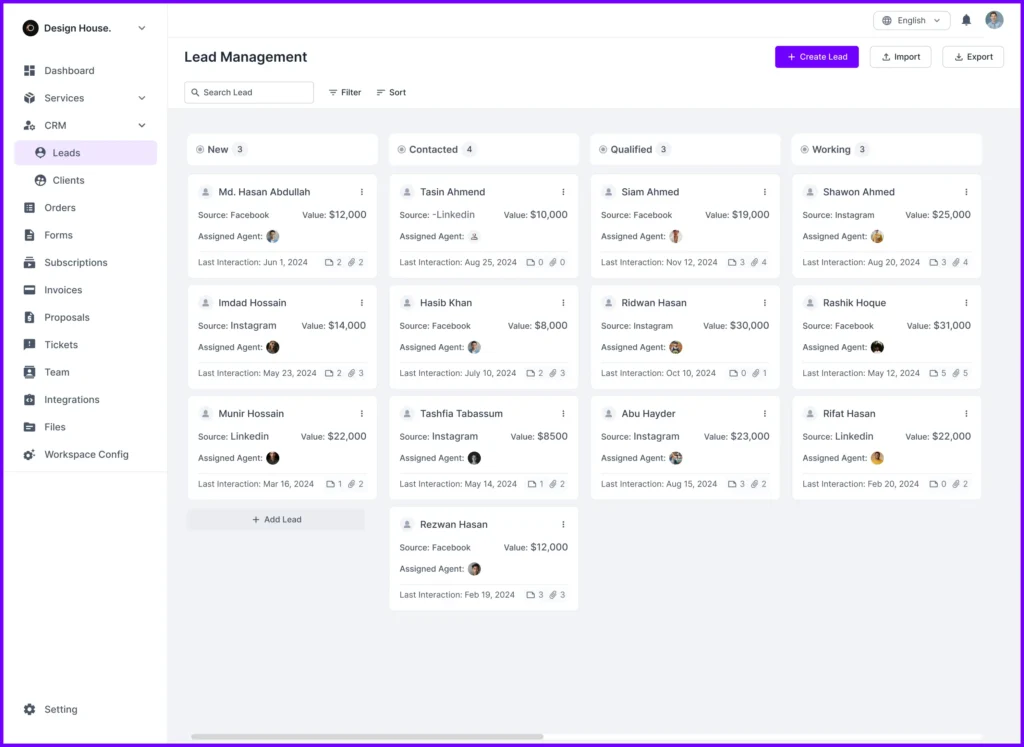
Service Listing
With Agency Handy, you can build multiple catalogs of your services. Plus, you can group related services, offer trials, and make your catalog public or embed it into your site.
Moreover, add-ons let you offer extras at a fixed price, and coupons give you control over discounts—set limits, durations, and who can use them. The Portfolio tool lets you show real work

Forms
It provides customizable intake and order forms to capture all the right details at the beginning of a project. You can ask for things like project goals, timelines, budgets, and more. Also, you can build add-ons and extra terms into the forms, ensuring clients know what’s included and what’s not.

Order and Task Management
Agency Handy helps you convert client orders into structured workflows. You can split large projects into smaller tasks, assign them to team members, set deadlines, and track progress visually on a Kanban board.
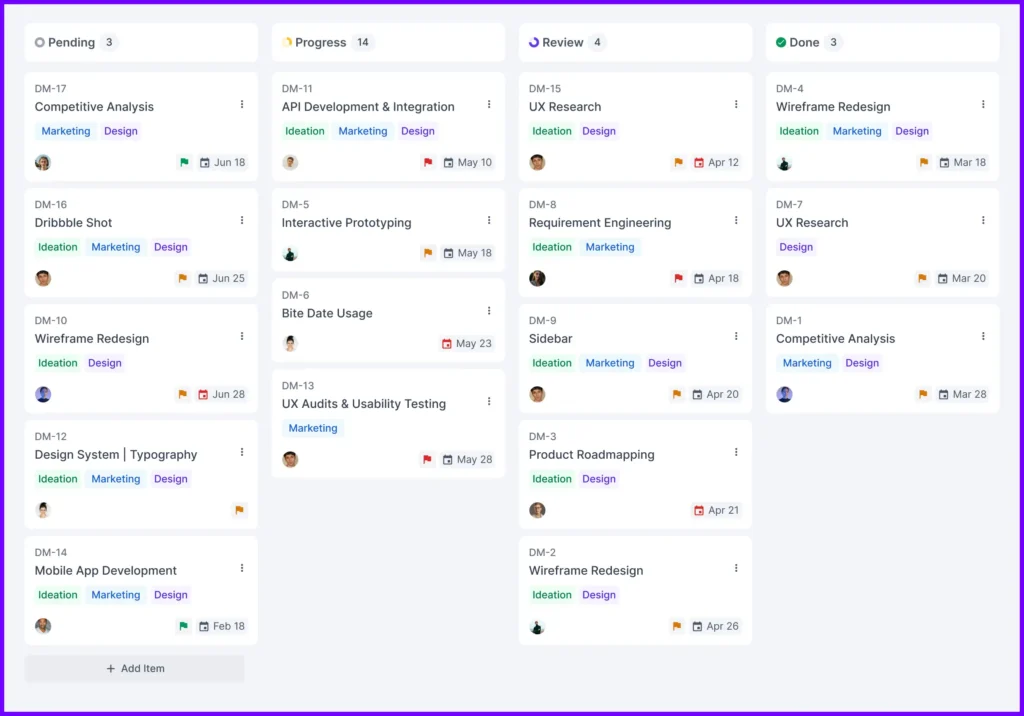
File Feedback
It offers simple tools for getting clear, actionable client feedback on any file. Clients can leave comments, use highlights or draw on images, PDFs, and even web previews. All feedback is stored in one place, linked to tasks and files.
This avoids endless revision loops and helps your team respond faster with fewer misunderstandings. Plus, multiple file versions keep your progress organized and transparent.
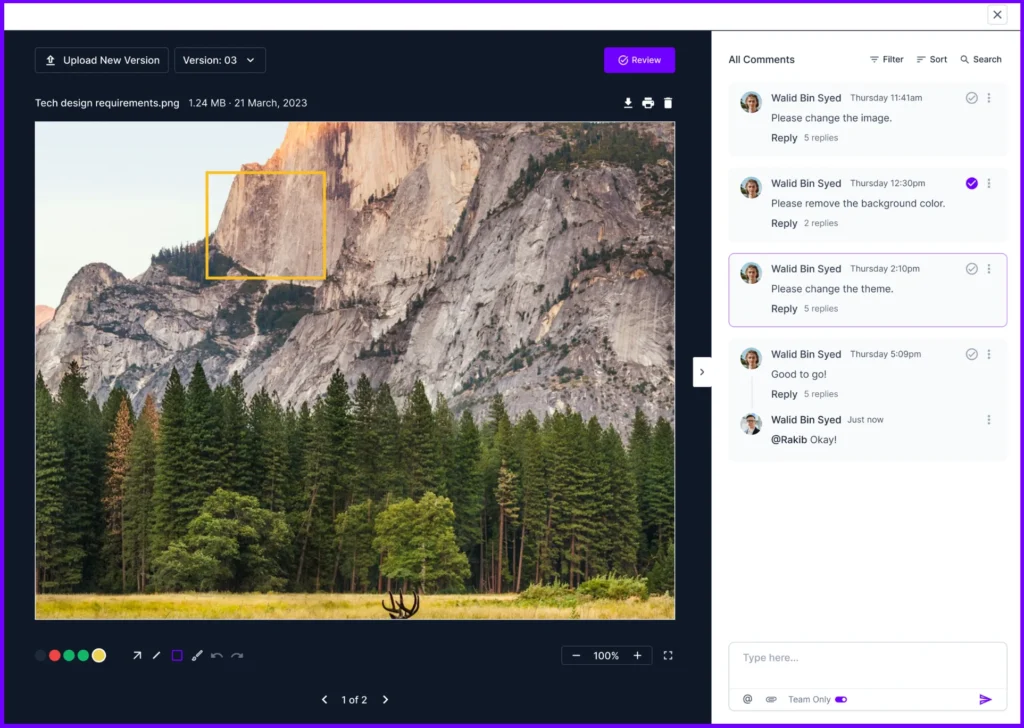
Invoices and Subscriptions
With Agency Handy, you can create invoices by hand or let the system auto-generate when an order comes in. Link each invoice to a client and order ID, set one-time or recurring charges, and choose your currency, BDT, USD, or whatever fits.
The totals, taxes, and discounts are calculated for you. Add notes, full billing info, and payment options like Wise. You can save drafts, set payment reminders, and update payment status anytime.

Ticketing
The built-in ticketing system lets clients submit support requests directly through their agency dashboard. You can track each ticket with a full activity history and assign it to the right team member with deadlines and priorities.
It keeps communication simplified, speeds up issue resolution, and ensures no request slips through the cracks.
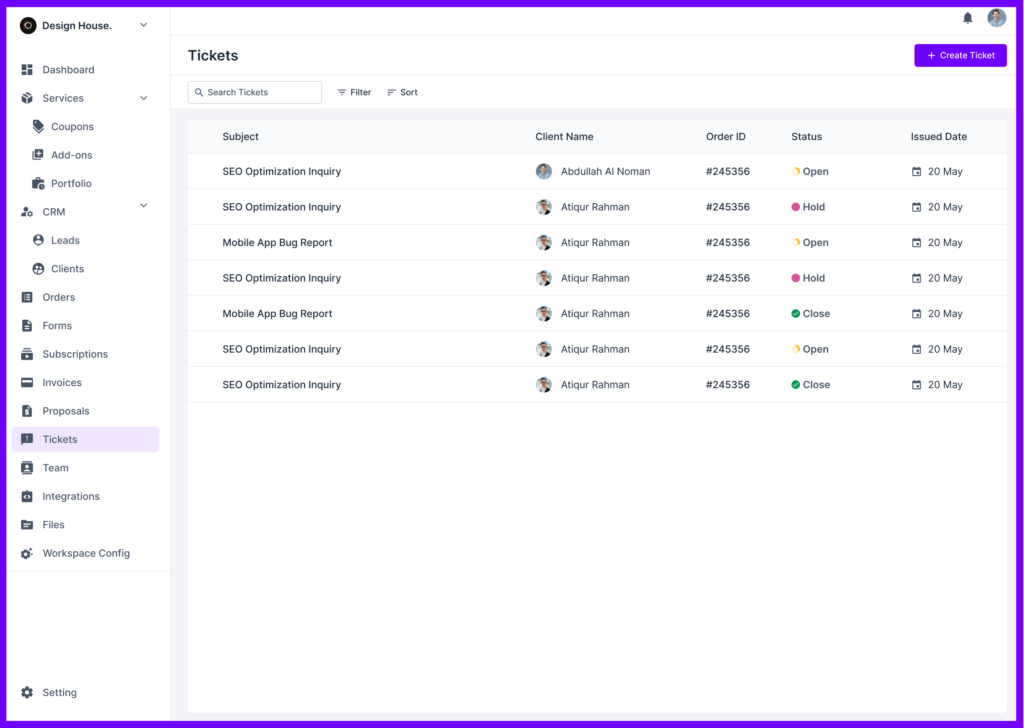
White Labeling
Agency Handy’s white-label system gives you full control over how the platform looks to your clients. You can customize the domain, use your logo and brand colors, and personalize emails, invoices, and proposals.
Even the sign-in portal and email templates can reflect your brand tone. It’s all included, even in the basic plan, so your agency always looks polished and consistent without extra fees.

Team Access
You can set access levels for each team member using roles like Super Admin, Admin, Manager, or Assignee. This means every person sees only what they need, helping you reduce clutter and protect sensitive data.
It also makes onboarding easier and ensures tasks and permissions are always clear and controlled.

Final Words
Agency management is about building trust, using time wisely, and staying financially steady. We’ve seen how structure, planning, and clear roles shape a smoother, healthier agency environment.
As agencies grow, choosing the right management method becomes key. That’s where Agency Handy comes in. It helps you manage tasks, feedback, billing, and client interactions, all in one place.
So, let’s focus on what matters: growing your agency.
FAQs
What is the structure of agency management?
The typical agency management structure starts with a CEO or founder at the top, followed by department heads like VPs and directors. Each leader oversees specific teams to ensure smooth operations, project delivery, and performance across all departments.
What does an agent manager do?
An agent manager runs daily team operations, sets clear goals, and monitors performance. They guide agents, resolve workflow issues, and make sure the team hits targets while maintaining smooth communication and accountability.
What mistakes do most new agencies make?
Common mistakes new agencies make include undercharging to attract clients, ignoring cash flow, micromanaging team members, and skipping written contracts. These issues often lead to trust problems, financial gaps, and project misalignment.




